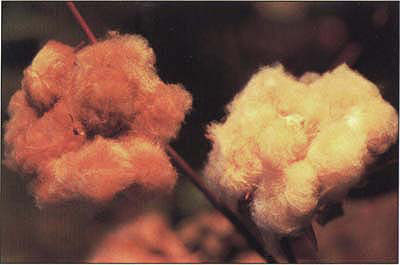All Issues
Farming in transition: News Briefs
Publication Information
California Agriculture 48(5):5-6.
Published September 01, 1994
PDF | Citation | Permissions
Full text
We introduce Farming in transition with three news items demonstrating the scope of this movement, from the most basic and deliberate field research — a comprehensive 100-year experiment — to the most applied, innovative efforts by industry to grow and market organic crops. —Ed.
Scientists study long-term sustainability
Scientists at UC Davis have established the only long-term study of irrigated agriculture in a Mediterranean climate, a 100-year investigation of the sustainability of agricultural systems and their impact on the environment.
Infrared photo of sudangrass grown on the LTRAS site revealed soil variability before the project began. Photo by Bill Wildman
The Long Term Research on Agricultural Systems (LTRAS) at UC Davis includes 72 one-acre plots planted with winter wheat, processing tomatoes, field corn and a legume cover crop. This year scientists began the first crop rotations to compare 10 cropping systems that differ primarily in their reliance on water and nitrogen inputs. For example, researchers will note how the crops perform when they receive just rain, as opposed to irrigation water, or when nitrogen is supplied by a legume cover crop rather than by a commercial fertilizer.
Definitions*
†Integrated pest management (IPM): Integrated pest management is an ecologically based pest management strategy that focuses on long-term prevention or suppression of pests through a combination of techniques such as biological control, alternative cultural practices and use of resistant varieties. Pesticides are used only when careful field monitoring indicates they are needed, and are selected and applied in a manner least disruptive to the environment.
‡Organic: Produce labeled organic is grown without synthetic fertilizers or pesticides, with some exceptions. Organic farmers substitute composts, crop rotation, mechanical cultivation, botanical pesticides and biological pest controls. Under pending federal law, prohibited materials must be discontinued 3 years before a crop can be labeled organic. Products labeled organic must meet specific requirements of the California Organic Foods Act of 1990.
‡Certified organic: Private certification organizations registered with the state certify farmers' compliance with the California Organic Foods Act of 1990. Some groups have supplementary requirements that are more stringent.
§Sustainable agriculture: Sustainable agriculture refers to farming systems that can maintain their productivity indefinitely. They must be resource-conserving, environmentally compatible, socially supportive and commercially competitive. They generally rely on biological processes such as soil-improving crops and biological pest control rather than external inputs such as synthetic fertilizers and pesticides, but often require higher levels of trained labor and management skill.
*Specific, research-related definitions of conventional and low-input agriculture appear on p. 15.
†Source: Integrated Pest Management Project at UC Davis.
‡Source: CDFA California Organic Program.
§While “sustainable agriculture” has no universally accepted definition, it is defined for the purposes of this special issue. Source: Jill Auburn, UC Sustainable Agriculture Research and Education Program.
Established at UC Davis in 1991, LTRAS evaluates sustainability from several standpoints: agronomic, economic and environmental. The Sustainable Agriculture Research and Education Program provided $150,000 of seed money, augmented in the last 2 years by $350,000 from the College of Agriculture and Environmental Sciences, $55,000 from the Division of Agriculture and Natural Resources and support from private industry.
Researchers will measure and analyze trends in soil properties that control yield, efficiency, profitability and environmental impact. Information learned from LTRAS will facilitate the design of new cropping systems to improve performance, according to Ford Denison, LTRAS director and associate professor of agronomy at UC Davis.
UC's long-term project is not the first; the Rothamsted (England) Experimental Station is 151 years old and the oldest U.S. plot was established in 1876 at the University of Illinois, Denison said. However, the others are rain-fed projects. This is an important distinction because archeological digs have revealed irrigated civilizations that collapsed. Researchers may find differences in accumulated salt, leaching of nitrate, weed populations and levels of organic matter. Other significant features are the number of acres and the inclusion of tomatoes, a major economic crop in California. Most of the other experiments are smaller and based on grain.
▪ Wine grapes lead organic conversion
California's wine grape producers are rapidly expanding organic acreage. More than 6,000 acres of wine grapes are currently certified by California Certified Organic Farmers and another 6,500 acres are in transition to organic. CCOF's Phil McGee attributed this growth to the consistent quality of the organic product and the anticipated loss of registration of many conventional farm chemicals.
Fetzer Vineyards and Sutter Home Winery are two of the larger wineries making the transition. In November, Fetzer Vineyards will be releasing its third vintage of wines made only from certified organic grapes. The winemaking process itself is not certified organic. The Mendocino County winery sells a chardonnay and a cabernet sauvignon under the label Bonterra, which loosely means “good earth,” marketing them to restaurants and small grocery stores, as opposed to chain stores.
The Bonterra label was launched in response to the surge of consumer interest in organic foods over the past 5 years, said Sid Goldstein, Fetzer senior vice president. The 26-year-old winery farms its 1,400 acres organically and aims to convert all of its outside growers to organic production by 2000. Initially it is more expensive, Goldstein said, due to increased labor costs, planting cover crops and modifying the irrigation system, but after the third year it becomes less expensive than conventional production. He named decreased cost, enhanced environment for workers and better quality fruit as the benefits. “We've come up a whole grade level in some vineyards,” he said.
Sutter Home began reducing its pesticide use to benefit workers' health and to protect the environment, public relations manager Olivia Marshall said. The winery began converting its 2,655 acres of vineyards in 1991, and all 10 Northern California vineyards will achieve certification status prior to the 1995 harvest. However, the Napa Valley winery does not market its wines as organic. Due to the large volume of wine it produces, Sutter Home must supplement its own crop with grapes from growers who may not farm organically, Marshall said.
She added that plans for estate bottling of organic wine at the company's small sister winery, Monteviña Winery in Amador County, are “on the drawing board.”
▪ Organic cotton acreage more than doubles
Since 1992, California cotton enrolled in an organic certification program more than doubled from 2,952 acres to 6,769 in 1994, according to the National Cotton Council. Textile companies are carving a niche for cotton grown without synthetic pesticides. Growers are receiving a handsome premium for certified organic cotton and only slightly lower prices for uncertified organically grown cotton.
Esprit and Patagonia are two companies advocating a shift to more ecologically compatible practices. Both analyze all aspects of their products for social and environmental impacts. Patagonia distributes its organic cotton apparel through specialty shops and its own mail order catalogues and retail stores. Since 1992, Esprit has been making Ecollection, a line of organic apparel sold only in Esprit's 200 retail stores in 17 countries. “That way we have control over how it is presented,” explained Dan Imhoff, spokesman for Esprit International. “People don't buy a product because it's organic, they buy it because it's the right price and style.” To build a market for organics, Esprit uses store displays to teach customers the differences between organic and conventional production.
Instead of dyeing organic cotton fiber, some environmentally conscious companies are using natural colored cotton.
Some companies are using natural colored cotton instead of dyeing the fiber. Golding Upholstery Fabrics weaves natural brown- and green-colored cotton with regular organic cotton to create a colorful pattern.
Organic cotton products are generally more expensive due to the higher priced lint and special processing. An $18 cotton T-shirt may retail for $24 if made of organic cotton. Certified organic cotton currently sells for about $1.20 per pound, roughly 50 cents more than conventionally grown cotton, according to cotton broker Mark Thompson of Anderson Clayton. Transitional cotton, grown on land that has not met the minimum 3 years of organic production required by most certification programs, may earn $1.12 to $1.15 per pound.
A premium is often needed to offset increased production costs and lower yields and grades. Mary Wadsworth, who oversees J.G. Boswell Company's 500-acre organic cotton project in Kings County, estimates that added labor increases organic production costs by about 50% over conventional cotton production. Boswell has been growing cotton organically since 1990. Wadsworth said that on average, organic yields have been about one-third lower than the farm's conventionally grown cotton. Yield losses are primarily due to insect damage, inadequate nitrogen at peak crop need, and less efficient harvesting conditions.
However, regional factors and management influence yields, said Ron Vargas, Madera County farm advisor, who has found organic cotton yields comparable to the countywide average for all cotton.
C & M Organic Enterprises is one of the largest growers and marketers of organically grown cotton in California. The Chowchilla-based company farms 5,000 acres of organically grown cotton. Michael Pettigrew of C & M estimates that 9,000 bales of California cotton were sold as organic last year. He expects that figure to rise by 20% this season.






